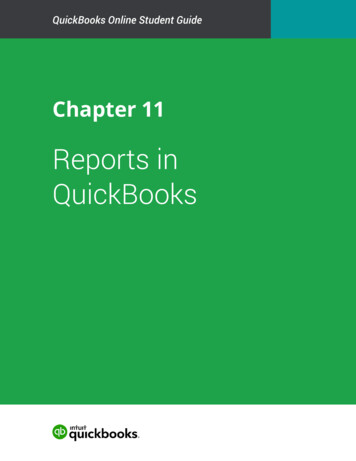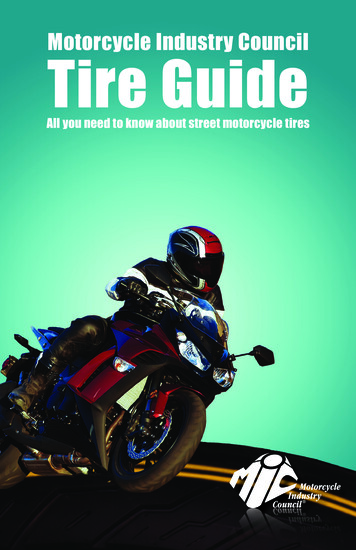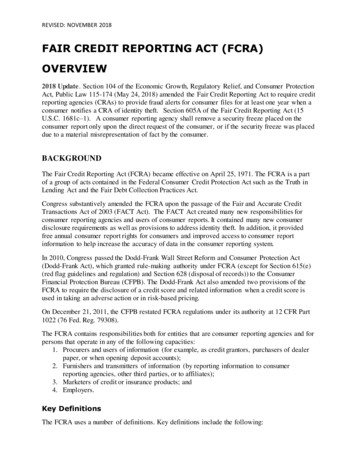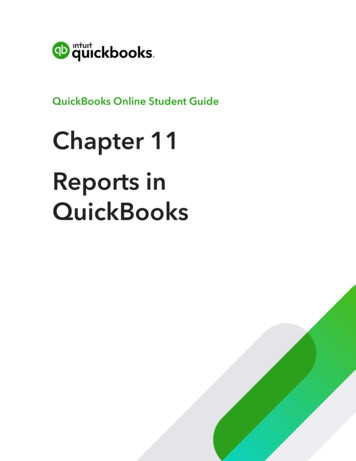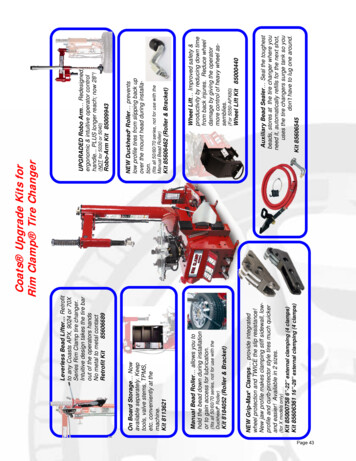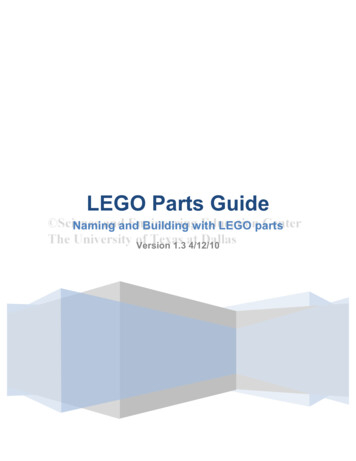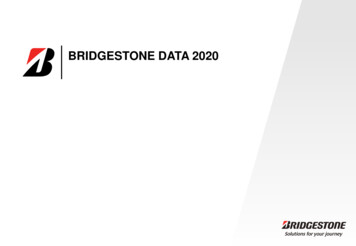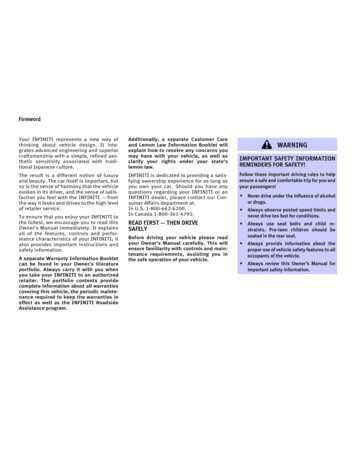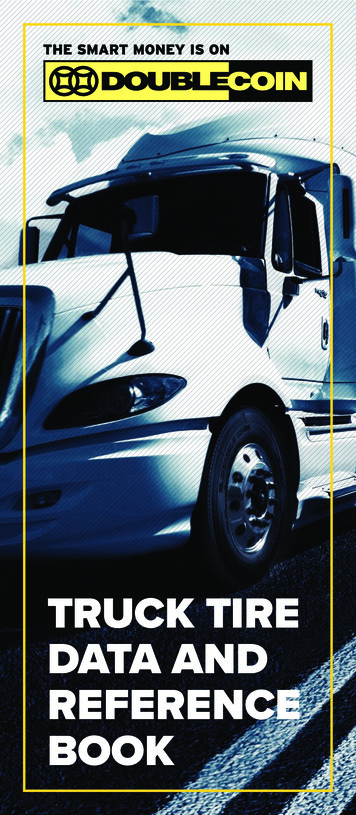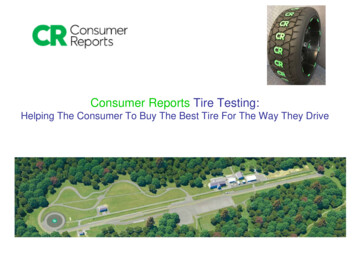
Transcription
Consumer Reports Tire Testing:Helping The Consumer To Buy The Best Tire For The Way They Drive
Consumer ReportsOn-lineMagazineSpecial Publications
Consumers drive tire testingMonitoring traffic on-lineConsumer feedback-Search engine optimization-Subscriber surveys-Consumer engagement(social media)What and where to buy tires is oftenasked.How do consumers buy tires?What products are consumers interested in?How does CR respond?
Consumer Buying PracticesSurvey Results: Fall of 2016 CR surveyed 48,525 subscribers who reportedon 50,125 tire purchase / installationexperiences.– Reason for replacing tires– What attributes do consumers look for– Shopping research
Retailer SurveyWhere to buy
Tire ReportsTruck TiresSurvey resultsCost Per Tire by Car TypePercent ofCar TypeCars inMedian Cost Per Tire*SurveySedan33% 145SUV31% 178Coupe/Hatchback/Wagon13% 137Pickup truck12% 187Minivan6% 142Sports car3% 187Other2% 152*Cost per tire shown controls for car type and includes only driversthat purchased and installed 4 tires at the same location.Car TiresUHP Tires
Tires onConsumerReports.orgApproximately 25 tire brands evaluated.Over 160 models .
Consumer Buying PracticesSurvey
Consumer Buying PracticesSurvey Attributes consumers seek when shopping–––––––––All weather grip (54%)Treadwear warranty (49%)Brand (47%)Handling (43%)Braking (31%)Free follow-up services (31%)Lowest price (31%)UTQG ratings (27%)Retailer recommendation (20%)
Consumer Oriented Performance TestsThree Season Performance:-Dry and wet braking-Hydroplaning resistance-Handling-RideWinter Performance:-Snow traction-Ice brakingValue:-Rollingresistance-Treadwear
Winter Traction Snow Traction– Acceleration, 5 to20 mph, measuredistance traveled. Ice Braking– Stopping distancewithout ABSbraking from 10 to0 mph on cold icesurface.
Ride and Noise Subjective test. Facility road courses– Concrete and asphaltsurfaces– Multiple raters General ComfortImpact ComfortNoiseSteering Feel
Wet and Dry Braking Wet and Dry braking– 60 to 0 mph (wet asphalt)– 60 to 0 mph (dry asphalt) CT DOT asphalt Burnished surface- “Traveled” surface Wet to 1.2 mm depth
Hydroplaning ResistanceHydroplaning690’radiusReport the speed at which hydroplaning occurs.
Handling Avoidance Maneuver– Double lane change Fastest speed Controllability rating Wet handling– Subjective handling, multipledrivers. Lap time Controllability rating
Rolling Resistance SAE J1269, steadystate rollingresistance.– Outside lab performsthe test.Future: Federal rating system?
Tread Life Evolving test emphasizing consumer orientated testing.– Tread life a key consumer feature. CR publishes a mileage estimate based on vehicle testing.Wear severity is an issue.– Testing: and time consuming.– Modern tires wear longer and perhaps differently from the days whenUTQG commenced 40 years ago.
Tread Life SeverityKey test conditions Government UTQG roads 16,000 mile test Approximate load*: 70% of maximum load. Typically placard inflation pressure.Wear severityCar Tires: 25-30% wornUHP Tires: 40-80% wornTruck Tires: 30-40% worn*Some variation by vehicle type
Treadwear Warranty vsTested Tread LifeCar TiresTread life trends most manufacturer warrantiesTire tread life longevity is a component of the overallscore. In addition, points are taken off for a shortfallin the claimed treadwear warranty.
Enhanced On-Line Tire PageVehicle and size selectors to view tested tire models
New categories of tires?All Weather TiresCUV TiresAll weather tiresFive models evaluated this year by CR.The appeal is no winter tire change over.Fueled by markets with mandatory winter use.CUV tires
All Weather Tires Results:– Tires are a compromise so are all weathertires.FeetAverage Snow Traction Performance (Distancetraveled to 20 rAll-SeasonPerformanceAll-season
Car, Truck, and Crossover TiresSource: Tom Carter, Michelin
Consumer EngagementSocial Media, On-line PanelJune 2018 In-depth dive into why and how consumersbuy replacement tires. Eight men and eight woman participatedwith an even mix from around the country
Consumer EngagementSocial Media, On-line Panel What prompted the purchase of new tires?– Most sited a visual inspection by the owner,but mechanic recommendation or stateinspection often was the means forconsidering replacement.– Few considered degradation of performanceexcluding snow traction.
Consumer EngagementSocial Media, On-line Panel What is the most important features toconsider in buying new tires?––––ValueBrakingBrandAll weather traction
Consumer EngagementSocial Media, On-line Panel What tires to buy?– Most researched tires before purchasing On-line– User reviews– Manufacturer web-sites Friends and family– Buy the best brand Buy by user reviews, familiarity, or perception– Value Long wear or low price– Buying original equipment tire was not apriority.
Consumer EngagementSocial Media, On-line Panel Do people check tire pressure?– Most do not and instead use TPMS as areminder.– Some check tire pressure every 1k miles, oilchange, or change of seasons
Consumer EngagementSocial Media, On-line PanelThe Shopping Experience? Mostlypositive! The Bad– Upsells– Took too long (2 hours )– Improperly installedsensors. The Good– Helpful employees– Good deal– Quick service– Money or credit for oldtires and wheels.
New tire buildingAdded capacityEfficiency UHP Tire Ratings Future Testing ConceptsTread loss influence on tiresCold braking of winter tires
Consumer Reports Tire Testing: Helping The Consumer To Buy The Best Tire For The Way They Drive. Consumer Reports On-line Magazine Special Publications. Consumers drive tire testing . Monitoring
